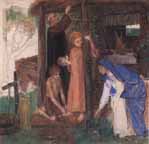
History and prophecy meet in Dante Gabriel Rossetti's The Passover in the Holy Family: Gathering Bitter Herbs. The young Christ occupies the center of the composition, and around him the other figures revolve. He stands holding on to a wooden beam with one hand and the bowl of lamb's blood in the other. His gaze leads to Mary, whose hand reaches down to gather the bitter herbs at his feet. On the ground, wearing a worn brown cloth, John kneels before Christ, binding his shoes. Standing behind John, Zacharius reaches directly above Christ's head to stain the porch with blood. Rossetti uses warm colors, and the green and blue in the painting verge on bright, but the visible lines and imprecise details create a worn effect, making the painting seem aged. The chain of actions and gazes moves the viewer's eye around the composition, and it creates a sense of a harmonious ritual. The symbols carried by each figure form a cohesive narrative that spans from the past to the future. In light of Rossetti's poem accompanying the watercolor, the scene carries the weight of the past and foretells Christ's crucifixion and resurrection.
Here meet together the prefiguring day
And day prefigured. 'Eating, thou shalt stand,
Feet shod, loins girt, thy road-staff in thine hand,
With blood-stained door and lintel,'--did God say
By Moses' mouth in ages passed away.
And now, where this poor household doth comprise
At Paschal-Feast two kindred families,--
Lo! the slain lamb confronts the Lamb to slay.
The pyre is piled. What agony's crown attained,
What shadow of death the Boy's fair brow subdues
Who holds that blood wherewith the porch is stained
By Zachary the priest? John binds the shoes
He deemed himself not worthy to unloose;
And Mary culls the bitter herbs ordained.
The scene stands between the prefiguring day -- Mose's leading the Jews out of Egypt -- and the day prefigured -- Christ, through his death and resurrection, leading human beings from sin to salvation. The Holy family pictured fulfills God's mandates for Passover voiced by Moses. Jesus holds the bowl, providing for Zacharius the blood of the sacrificed lamb that will keep the Angel of Death away, but it also symbolizes that through his Crucifixion, Jesus sacrifices his blood to save mankind from death. The blood he holds and the blood above him foreshadows his Crucifixion and the redemption that comes from it. Below him, the bitter herbs required for the ritual serve as the reminder of the suffering of the Jews. At his feet, they ground Christ in the biblical past, linking him to the chosen people of the Old Testament. The bitter herbs represent the suffering he and his mother will face when he fulfills the sacrifice of his own body. John stands before Jesus, preparing his sandals. This action illustrates John's words from the gospel: "He who is coming after me is mightier than I, whose sandals I am not worthy to carry" (Matthew 3:11). The line that flows from Zacharius, to Christ, and down to Mary mirrors another, subtler line -- that from Christ, to John, to the crossed beams by the well. John prepares the way for Christ through Baptism, a ritual prefigured by Moses's striking the rock and fulfilled by Christ's rise from death to new life.
Questions
1. "Gathering the herbs" makes up the title and serves as the final phrase of Rossetti's poem. Why does Rossetti hightlight this detail more than the other aspects of the Passover ritual?
2. The technique of the painting, with its rough color and lack of carefully rendered details, is not like other Pre-Raphaelite works. What effect does Rossetti's technique have on the perception and interpretation of the work?
3. Rossetti did not want the connection of the sacrifices to be a case in "which the symbolism is not really inherent in the fact, but merely suggested or suggestible, and having had the fact made to fit it." Does Rossetti succeed, as he claims? Why or why not?
4. Is Rossetti's work more or less successful than Christ in the House of His Parents? Does Rossetti do a better job of connecting Christ to those that prefigure him? Do you think Rossetti's painting would be less effective without the accompanying poem?
Related Materials
Last modified 27 June 2020